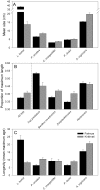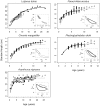Predator-induced demographic shifts in coral reef fish assemblages
- PMID: 21698165
- PMCID: PMC3116880
- DOI: 10.1371/journal.pone.0021062
Predator-induced demographic shifts in coral reef fish assemblages
Abstract
In recent years, it has become apparent that human impacts have altered community structure in coastal and marine ecosystems worldwide. Of these, fishing is one of the most pervasive, and a growing body of work suggests that fishing can have strong effects on the ecology of target species, especially top predators. However, the effects of removing top predators on lower trophic groups of prey fishes are less clear, particularly in highly diverse and trophically complex coral reef ecosystems. We examined patterns of abundance, size structure, and age-based demography through surveys and collection-based studies of five fish species from a variety of trophic levels at Kiritimati and Palmyra, two nearby atolls in the Northern Line Islands. These islands have similar biogeography and oceanography, and yet Kiritimati has ∼10,000 people with extensive local fishing while Palmyra is a US National Wildlife Refuge with no permanent human population, no fishing, and an intact predator fauna. Surveys indicated that top predators were relatively larger and more abundant at unfished Palmyra, while prey functional groups were relatively smaller but showed no clear trends in abundance as would be expected from classic trophic cascades. Through detailed analyses of focal species, we found that size and longevity of a top predator were lower at fished Kiritimati than at unfished Palmyra. Demographic patterns also shifted dramatically for 4 of 5 fish species in lower trophic groups, opposite in direction to the top predator, including decreases in average size and longevity at Palmyra relative to Kiritimati. Overall, these results suggest that fishing may alter community structure in complex and non-intuitive ways, and that indirect demographic effects should be considered more broadly in ecosystem-based management.
Conflict of interest statement
Figures



References
-
- Pandolfi JM, Bradbury RH, Sala E, Hughes TP, Bjorndal KA, et al. Global trajectories of the long-term decline of coral reef ecosystems. Science. 2003;301:955–958. - PubMed
-
- Jackson JBC, Kirby MX, Berger WH, Bjorndal KA, Botsford LW, et al. Historical overfishing and the recent collapse of coastal ecosystems. Science. 2001;293:629–638. - PubMed
-
- Roberts CM. The unnatural history of the sea. Washington, DC: Island Press; 2007. 435
-
- Jennings S, Kaiser MJ, Reynolds JD. Marine Fisheries Ecology. Oxford: Blackwell; 2001. 417
-
- Jennings S, Kaiser MJ. The effects of fishing on marine ecosystems. Advances in Marine Biology. 1998;34:201.
Publication types
MeSH terms
LinkOut - more resources
Full Text Sources

